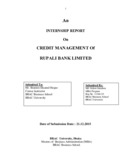Credit management of Rupali Bank Limited

View/Open
Date
2015-12-21Publisher
BRAC UniversityAuthor
Samdani, Md. GolamMetadata
Show full item recordAbstract
Rupali Bank Ltd. (RBL) was constituted with the merger of 3 (three) erstwhile commercial banks i.e. Muslim Commercial Bank Ltd., Australasia Bank Ltd. And Standard Bank Ltd. operated in the then Pakistan on March 26, 1972 under the Bangladesh Banks (Nationalization) order 1972 (P.O. NO. 26 of 1972), with all their assets, benefits, rights, powers, authorities, privileges, liabilities, borrowings and obligations. Rupali Bank worked as a nationalized commercial Bank till December13, 1986. Rupali Bank Ltd. Emerged as the largest Public Limited Banking Company of the country on December 14, 1986. At present Rupali Bank Ltd. Operates through 550 branches. It is linked to its foreign correspondents all over the world. The Corporate Head Office of the bank is located at DHAKA with one local office (main branch), six corporate branches at Dhaka, one in Chittagong and twenty-five zonal offices all over the country. The Board Of directors is composed of eight members headed by a chairman and the directors comprise representatives from both public and private sectors and shareholders. The Bank is headed by the Managing Director (Chief executive) Mr. Md. Farid Uddin who is a reputed professional Banker. The Bank has an authorized capital of TK. 7000 million with a paid up capital of TK. 1650 million. GOB owns 90.19% of its share while the private share constitutes only 09.81%.
As an employee, I had the opportunity to do the different types of tasks under Rupali Bank Limited. To make this report, I have used my observations about various banking functions and day-today operations. Rupali Bank Limited provides different types of services to its customer’s like-
Foreign exchange.
General banking etc.
I segmented my report into eleven chapters. First covers the Introduction about the report, second chapter covers the Organizational overview of Rupali Bank Limited. Third chapter consists of Financial Analysis of Rupali Bank Limited. Fourth chapter is for the Credit Policy of Rupali Bank Limited; Fifth chapter includes Credit Appraisal System of Rupali Bank Limited, Sixth chapter is for Project Appraisal Practices of Rupali Bank Limited and remaining chapter consists of Supervision and Recovery of Loans and Advances, Credit Risk management Practices, Operational Result, Findings, Recommendation and Conclusion. This report will provide a view regarding the products and performance of the Rupali Bank Limited.
Financial institutions of a country play an important role in mobilizing the unutilized savings and guiding their way through to useful investment projects. The financial institutions go a long way in building the financial backbone of the country’s economy. Through capital rising, loan providing, lending supports to venture new entrepreneurs with their concerns, the financial institutions are driving the nation towards financial solvency. In a developing country such as Bangladesh, the role of financial institutions is imperative. Here the financial institutions mostly comprise commercial banks, that is, the major portion of financing for businesses and a majority of the core financial banks provide services. By the nature of their business, banks are very good at mobilizing savings and providing payment services and liquidity. As such they facilitate economic growth for the country. A major source of the revenue’s is the varieties of loan products that they offer.
Loan products are one if the key components of eth banks assets. Most of the revenues generated by banks are generated through the loan products. One of the market leaders of the banking sector of Bangladesh, Rupali Bank Ltd. is no exception in this regard. Through their strong brand image and affiliation with a large parent company, they are able to provide innovative services to the consumers of a developing country such as ours. Among its various products, one of the key products is the “Personal loan for Consumers” which we have selected as the area for our study.
